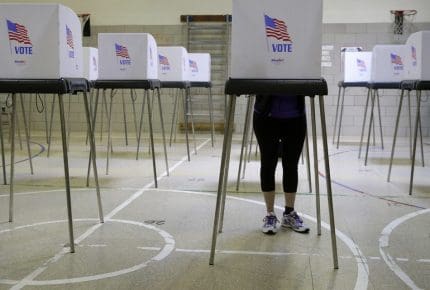Latinos and Asian Americans are still vastly underrepresented in Congress
New analysis shows both populations make up just a small percentage of the 117th Congress, though they’ve made important strides in recent years.

The demographic makeup of the 117th U.S. Congress is the most diverse in history, but a new report reveals troubling gaps in representation among Hispanic Americans and those of Asian or Pacific Islander descent.
According to a Pew Research Center analysis released Thursday, Hispanic American lawmakers make up 9% of the 117th House of Representatives, but 19% of the general U.S. population. Asian Americans and Pacific Islanders (AAPI), who account for approximately 6% of the national population, make up just 3% of the chamber.
In the upper chamber, there are only six Latino senators, two Asian senators, and three Black senators.
Latinos and AAPI Americans have traditionally been overlooked in politics more broadly.
Only 1% of all local and federal elected officials are Latino, according to USA Today. As of 2016, Asian-Americans and Hispanics made up fewer than 2% of all state and local elected offices, according to a report by the New American Leaders Project.
Still, experts say there have been important strides in recent years.
“What we see from this report is that Asian-Americans and Latinos face barriers, yes, but that despite this, they run and win,” New American Leaders Project president Sayu Bhojwani told the New York Times in 2016.
Latinos and Asian American women in particular have been shattering glass ceilings, and despite the overarching disparities, the number of women of color in Congress has recently hit an all-time high.
New Mexico became the first state this year to elect all women of color to Congress.
Rep. Michelle Steel (R-CA) also became the first Korean American women elected to the House in January.
A record number of AAPI lawmakers overall were seated for the 117th Congress, with 21 members of the historically underrepresented population elected or reelected to the House of Representatives and the Senate.
The National Association of Latino Elected and Appointed Officials also noted in December that voters had sent 39 Latino House members and one new Latino senator to Congress as well.
“…The candidates who ran for office this election cycle reflect the geographic and ideological diversity of the Latino community,” the group said in a statement. “These candidates ran competitive races all across the country, once again demonstrating that Latinos can win from coast to coast.”
The slow rise in numbers at the federal level comes at a time when both the AAPI and Latino voting blocs are expanding.
AAPI voters are the fastest-growing bloc, with states seeing an increase in 2020 turnout greater than any other demographic, according to the Washington Post.
Analysis by Democratic political strategist Tom Bonier found that in crucial battleground states President Joe Biden won in November, like Georgia and Arizona, the increase in the number of Asian American voters was greater than his margin of victory.
“From this dataset emerges perhaps one of the least heralded stories that might just stand as one of the most important electoral trends behind the results: an unprecedented surge in participation among Asian American/Pacific Islander (AAPI) voters,” Bonier wrote.
Turnout among Latino voters has also risen. As USA Today notes, “Latino voter turnout in 2018, at 40%, reached a record high, increasing from 6.8 million in 2014 to 11.7 million.” And NBC News reported in November that Black and Latino votes, especially those cast by young people, were pivotal to Biden’s victory.
“Make no mistake: Black and Latinx voters delivered this win. We knew the path to victory for Pennsylvania and the presidency ran through communities of color,” Maegan Llerena, state director of Make the Road Action in Pennsylvania, told the outlet.
Llerena cited the pandemic as a driving issue behind the rise in turnout.
“In a pandemic that’s disproportionately killed and infected Latinx and Black communities, our lives were on the line, and our people were motivated,” she added.
At least 8.6 million Latino voters cast their ballots early in 2020, the outlet noted.
Published with permission of The American Independent Foundation.
Recommended

Florida abortion ban puts GOP Rep. Anna Paulina Luna’s anti-choice views in spotlight
Luna supports abortions bans with no exceptions for rape
By Jesse Valentine - May 07, 2024
Republican Caroleene Dobson wants Alabama abortion ban to go nationwide
Dobson is the Republican candidate in what will be one of the most-watched House races of 2024.
By Jesse Valentine - April 30, 2024
Direct mailers distort California Democrat Will Rollins’ record
Rollins, a former federal prosecutor, is challenging incumbent GOP Rep. Ken Calvert.
By Jesse Valentine - April 25, 2024







































































